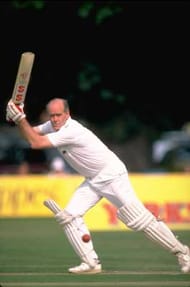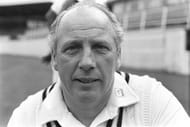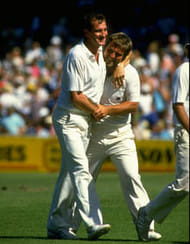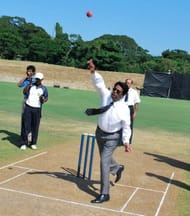Pravin Tambe must be cursing his bad luck. Four days after a wonderful Champions League tourney and two days after his 42nd birthday, the entire nation swivelled its spotlights around to another 40 year old – this time for his retirement. Those who were smothering Tambe with praise a few days back now had nothing but tears of sorrow at the “end of Indian cricket as a religion”.
But he should thank his good luck as well. Had Brad Hogg not decided to play for Perth Scorchers, he might not have been in the starting XI as well. In fact, had Ankeet Chavan and Ajit Chandila not decided to indulge in a spot of spot-fixing, he might not have been in the squad as well. Chandila, after all, had taken a hat-trick in his first season with the Rajasthan Royals while Chavan, along with Iqbal Abdulla, had been marked as the spinning spearheads of Mumbai’s bowling attack.
But now (or at least before Tendulkar’s retirement), everyone is talking about Pravin Tambe. If he was 22, they would have named him the saviour of Indian spin bowling; if he was 32, they would have christened his efforts as a mid-life resurgence; at 42 they hail it as nothing less than a miracle – a sign from the heavens above. So much so that a certain school of followers believe that Tambe should be considered a serious candidate for the India blue.
In his favour, there have been men who have played cricket when many considered their time was up. To be honest, most of them existed at a time when the game was clearly demarcated for amateurs and professionals and when there was not a lot of money riding on the results. But even if we were to restrict ourselves to a time period since the advent of ODIs and take into account only Test playing nations we would be pleasantly surprised to see the results of 42 year olds playing international cricket. Co-incidentally quite a few of them are also spinners by profession.
John Traicos – In 1970, the Egypt-born off-spinner John Traicos made his debut for South Africa against Australia in what would turn out to be their last Test series for quite some time. Like his contemporaries, Traicos was expected to play county cricket in England or be a part of the South African teams which played the rebel teams over the next two decades or both. Instead he took the path less beaten to Rhodesia and plied his trait for Mashonaland over the years.
His strategy seemed successful when 13 years later, at the age of 36, Traicos made a successful ODI debut against Australia in the 1983 World Cup. Thereafter he appeared in the 1987 World Cup in the subcontinent which many expected would be his swansong at 40.
It, therefore, took many by surprise when he was a part of Zimbabwe’s third World Cup campaign at a young old age of 45. Most of the cricketing world had taken this as his final hurrah.
Six months later, Traicos played his fourth Test match and first for Zimbabwe against India taking 5 for 86. Even at 45, he was the best spinner in the country and among the finest in the world. And those who have seen him field say that his reflexes at gully would match that of a 20 year old.
Traicos ended his career on the tour of India the next year. He would have been on the plane to Pakistan for the next tour but for his business commitments which, at that time, seemed far more profitable than playing for Zimbabwe.
Brian Close – Brian Close was touted to be England’s post-war batting hero – a man with a big bat and a bigger heart. But despite the immense promise he displayed for Yorkshire, none of that translated to the big stage as, when his Test career appeared to have ended in 1967, he had gone 18 years with a single half-century.
5 years later at the age of 41, he was called up to the England ODI team for the first ever ODI series after the successful launch of the format a year before. He flattered none and was expected to have been consigned to the dustbins of history after the series ended.
Four years later, he was back in the England test squad at the age of 45 facing up to what was probably the fiercest bowling attack of all-time. The West Indies had Tony Greig’s men grovelling but Close clung on to his pride as he took blows to the body throughout the series without an ouch and made a well-fought 60 at Lord’s – his highest score in Tests.
Norman Gifford – Unlucky to be sandwiched between Tony Lock and Derek Underwood, Norman Gifford’s career never took wing and he seemed to have played the last international match of his career against New Zealand at Lords in 1973.
Hence quite a few people took notice when a 45 year old Gifford took the field as captain on debut for a second-string England side in the Rothmans Four Nations Cup at Sharjah in 1985. They pushed Australia to the brink in the first match which was decided off the last ball as Gifford bowled out his spell of 10 overs for a miserly 27 runs. He was even better the second time around taking 4 for 23 off his full quota of overs against Pakistan but the inexperienced English team had no answers to the wiles of the Pakistan bowling attack.
John Emburey – Before Shane Warne, John Emburey could have applied for the right of being the best spin bowler in the world. Even if that is something of an overstatement, Emburey was definitely the best off-spinner of his time and the best spinner England had produced since Derek Underwood.
It is understandable then that England decided to call on his resources at the age of 40 for the tours of India and Sri Lanka and the Ashes which followed. Emburey had marginal successes, the most notable of them being his form with the bat where he notched up consecutive scores of 59, 55 not out and 37 against Sri Lanka and Australia. But that was all to it.
Two years later Emburey was back at 43 playing the West Indians at Old Trafford. While his 30 overs went wicketless, Emburey caught Junior Murray off the bowling off Mike Watkinson and helped Dominic Cork swell England’s lead past 200 with a 51 minute 8 with the bat.
Somachandra de Silva – Like Traicos, Somachandra de Silva’s story is an unfortunate one of “too late, too little”. De Silva was the best Test spinner Sri Lanka had produced before Muralitharan but he was already 33 when Sri Lanka got a chance to play in the first World Cup. He continued to plug away for them over the years and was a part of their historic victory over India in the 1979 World Cup.
In 1982, Sri Lanka was given Test match status and de Silva got the opportunity to play Test cricket at the age of 40. He made the most of his limited opportunities – be it taking Sri Lanka’s first Test five-for against Pakistan en route to 17 wickets in three Tests or scoring two fifties as captain in New Zealand. He continued to play cricket late into his 43rd year and finally bowed out of international cricket at the World Championship of Cricket in Australia in 1985.
Notable mentions
Bob Taylor – Understudy to Alan Knott for over a decade, Taylor came into his own as a wicketkeeper of prominence in his early forties and stayed on till he was almost 43.
Clive Rice – A bulwark of South African cricket in his prime and in their isolation years, Rice was given the captaincy of the team at 42 on their return to international cricket in 1992. This was a mere formality as months later he was deemed as too old to take them to the World Cup.
Fred Titmus – A master of off-spin, Titmus seemed to have ended his career against West Indies in Jamaica at the age of 36 in 1968. He was recalled for the 1974-75 Ashes Down Under where he took 4 for 107 at Melbourne. He followed that up with 3 for 53 at Wellington in his debut and final ODI series against New Zealand.
Bob Simpson – Having played what seemed like his last Test at 32 against India in 1968, Simpson came back 10 years later to helm a new look Australian side stung by the Packer exits. His captaincy and competency of playing spin gave Australia the edge as they narrowly edged out India 3-2 before sobering up to a 3-1 defeat in the Caribbean.
Colin Cowdrey – Another of England’s post war greats, Cowdrey was recalled along with Titmus for the 74-75 Ashes at the age of 42. It was a chastening experience though as he could only manage a highest score of 35 in the five Tests.
Brand-new app in a brand-new avatar! Download CricRocket for fast cricket scores, rocket flicks, super notifications and much more! 🚀☄️




